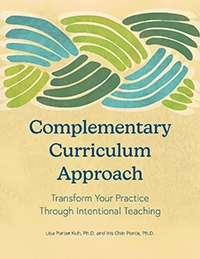ExchangeEveryDay Past Issues
 << Previous Issue
| View Past Issues | | Next Issue >>
<< Previous Issue
| View Past Issues | | Next Issue >> -Indira Gandhi (1917-1984), first female Prime Minister of India
In Caring Spaces, Learning Places, Jim Greenman defined the environment as the external conditions and factors that might influence us, not just the physical space, “but also how time is structured, roles are allotted, and expectations of our behavior are formed.” The environment is physical, sensory (light, smells, textures, colors, sounds, temperature…), social and even temporal. Greenman goes on to say, “The physical and social environment plays a major role in our social and psychological lives, influencing the stress we experience in accomplishing personal and group goals, the form and nature of our social contacts, and our feelings of identity and self-worth.”
In discussing the Prepared Environment in their new book Complementary Curriculum Approach, Lisa Porter Kuh and Iris Chin Ponte note, “It is important to reconsider some well-ingrained norms about what early childhood classrooms should look like and how they should be set up for learning. With guidance from legacy thinkers in early education, teachers can design classrooms that reflect their values about childhood and the teaching and learning experience.”
Throughout their discussion, Porter and Kuh offer helpful points of reflection: What is the first thing you see? How do you feel in your room? And, “What do you need from your surroundings to do your best work and learning? What do the children need? This is about more than beautiful classrooms painted in soft tones. It is also about children’s access to prepared environments that are interesting, spark independence and agency, and are happy and joyful places to learn. This kind of environment should be a right for every child.”
Share your thoughts in the comments about how your environment impacts you and the children in your care.
Reminder!
Applications for the Exchange Leadership Initiative are due this Monday, March 28! Visit: exchangepress.com/leadership
Complementary Curriculum Approach Transform Your Practice Through Intentional Teaching |
ExchangeEveryDay
Delivered five days a week containing news, success stories, solutions, trend reports, and much more.
What is ExchangeEveryDay?
ExchangeEveryDay is the official electronic newsletter for Exchange Press. It is delivered five days a week containing news stories, success stories, solutions, trend reports, and much more.



Comments (1)
Displaying 1 CommentUniversity of Phoenix/ Red Rocks Community College
Denver, Colorado, United States
In my long experience with programs for young children, I think there are three overall things that are often lacking regarding the environment. 1) A responsive environment. Children need to be able to control and manipulate their environment. This gives them a sense of power and enables them to match the environment with their reeds. 2) Change. Most environments for young children are much too boring and static. The longer the child's day in a program the more the need for change. And 3) an understanding that the outdoors is as important an environment as the indoors.
Post a Comment